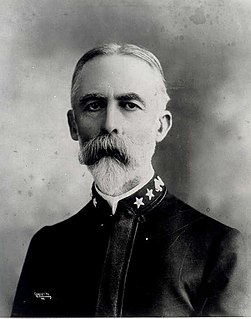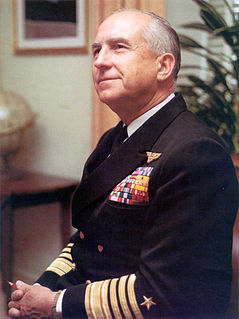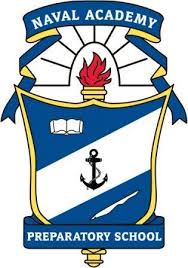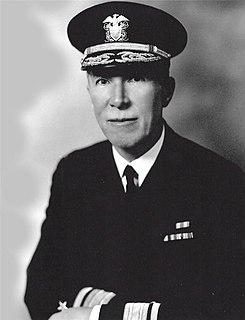
The Distinguished Flying Cross (DFC) is a military decoration of the United States Armed Forces. The medal was established on July 2, 1926, and is currently awarded to any persons who, after April 6, 1917, distinguish themselves by single acts of heroism or extraordinary achievement while participating in aerial flight. Both heroism and extraordinary achievement are entirely distinctive, involving operations that are not routine. The medal may be awarded to friendly foreign military members in ranks equivalent to U.S. Pay Grade of O-6 and below, in actual combat in support operations.

William Thomas Sampson was a United States Navy rear admiral known for his victory in the Battle of Santiago de Cuba during the Spanish–American War.

Thomas Hinman Moorer was an admiral and naval aviator in the United States Navy who served as the chief of Naval Operations from 1967 to 1970, and as the seventh chairman of the Joint Chiefs of Staff from 1970 to 1974.

The Sampson Medal was a U.S. Navy campaign medal. The medal was authorized by an Act of Congress in 1901. The medal was awarded to those personnel who served on ships in the fleet of Rear Admiral William T. Sampson during combat operations in the waters of the West Indies and Cuba. The Sampson Medal was also known as the West Indies Naval Campaign Medal, not to be confused with the West Indies Campaign Medal which was a separate award. A similar commemorative decoration was the Dewey Medal, considered senior to the Sampson Medal.

The Mexican Service Medal is an award of the United States military for service in Mexico from 1911 to 1919.

Noteworthy events of Guantánamo Bay.

Joseph Knefler Taussig was a vice admiral in the United States Navy. He served in the Spanish–American War, Philippine–American War, China Relief Expedition, Cuban Pacification, World War I, Second Nicaraguan Campaign, and World War II.

The Naval Academy Preparatory School or NAPS is the preparatory school for the United States Naval Academy. NAPS is located on Naval Station Newport, Rhode Island. The mission of the Naval Academy Preparatory School is "To enhance Midshipman Candidates' moral, mental, and physical foundations to prepare them for success at the United States Naval Academy".
The Haitian Campaign Medal was a United States Navy military award which was first established on June 22, 1917, and again on December 6, 1921.

Cameron McRae Winslow served in the United States Navy during the Spanish–American War and World War I. A son of Commander Francis Winslow (I) (1818–1862),
The Military Order of the Loyal Legion of the United States (MOLLUS), or simply the Loyal Legion is a United States patriotic order, organized April 15, 1865, by three veteran officers of the Army. The original membership was composed of members of the Army, Navy, or Marine Corps of the United States, who had served during the American Civil War as commissioned officers in Federal service, or who had served and thereafter been commissioned, and who thereby "had aided in maintaining the honor, integrity, and supremacy of the national movement" during the Civil War.

Albert Thomas Church III is a retired vice admiral in the United States Navy. Church served as on active duty for 36 years, retiring as a vice admiral in 2005. During his service he commanded two warships, the Navy's largest shore installation at Naval Station Norfolk, Virginia, and was the longest-serving budget director of the Navy (1998–2002). Church also served as the Naval Inspector General, during which time he completed a comprehensive review of interrogation techniques used by the Department of Defense in Iraq, Afghanistan, and at Guantanamo Bay, Cuba. He is currently president of Prescient Edge Corporation, a US-based national security services and technology Firm.

Walter Stratton Anderson was a Vice Admiral of the United States Navy, who served as the Executive officer of USS Arizona in World War I and as Commander Battleships, Battle Force in the Pacific Fleet, and of the Gulf Sea Frontier, during World War II.
Hispanics in the United States Naval Academy account for the largest minority group in the institution. According to the Academy, the Class of 2009 includes 271 (22.2%) minority midshipmen. Out of these 271 midshipmen, 115 are of Hispanic heritage. In 2004, of the total of 736 female midshipmen, 74 (10%) of them were of Hispanic descent.

The Military Order of Foreign Wars of the United States (MOFW) is one of the oldest veterans' and hereditary associations in the nation with a membership that includes officers and their hereditary descendants from all of the Armed Services. Membership is composed of active duty, reserve and retired officers of the United States Armed Services, including the Coast Guard, National Guard, and allied officers, and their descendants, who have served during one of the wars in which the United States has or is engaged with a foreign power.

Royal Eason Ingersoll was a United States Navy four-star admiral who served as Commander in Chief, U.S. Atlantic Fleet (CINCLANT) from January 1, 1942 to late 1944; Commander, Western Sea Frontier from late 1944 to 1946; and Deputy Commander in Chief, U.S. Fleet/Deputy Chief of Naval Operations (DCOMINCH/DCNO) from late 1944 to late 1945.
The Naval War College Distinguished Graduate leadership Award was established in 1996 by the Trustees of the Naval War College Foundation to honor United States Naval War College graduates who have attained positions of prominence in the field of national security.
The Naval Order of the United States was established in 1890 as a hereditary organization in the United States for members of the American sea services. Its primary mission is to encourage research and writing on naval and maritime subjects and preserve documents, portraits, and other records of prominent figures, deeds and memories of American naval and maritime history.
The Distinguished Sea Service Award is an annual award of the Naval Order of the United States recognizing a recently retired flag or general office of the maritime services of the United States.













